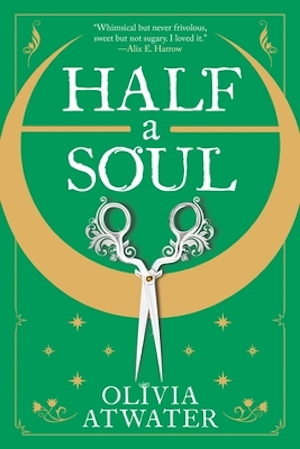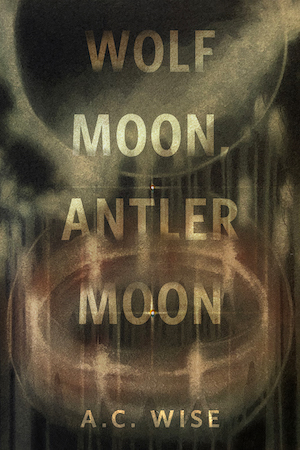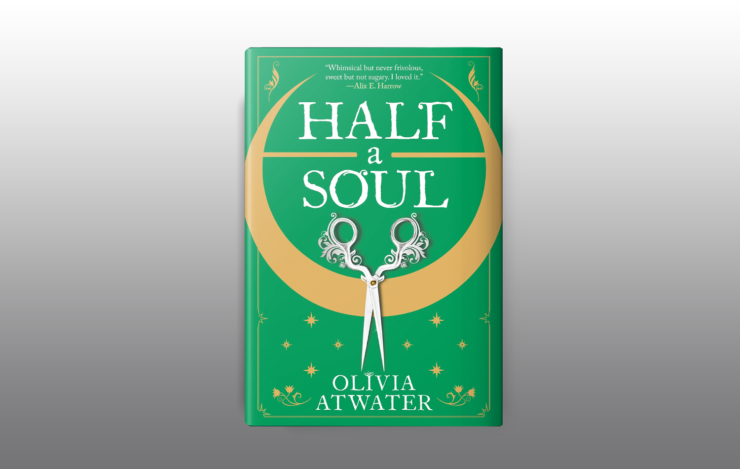The perpetual allure of the Regency era can be chalked up to many things, including its links to Jane Austen, the lengthy careers of writers like Georgette Heyer and Marion Chesney, and the inherent eroticism of absolutely nobody ever getting to bone. I believe the latter is the reason Barbara Cartland gave for writing so many Regency romances. (Do not fact-check this.) It’s a particularly elegant fit for romance, which, more than any other genre, depends upon clearly defined rules. Likewise, the Regency elite—or at least the version of them that survives in popular memory—were closely bound by rules of conduct, modesty and virtue. By dint of a book being set in the Regency, the reader already knows many of the beats it will follow; by dint of its being a romance, we know that the central characters will fall in love and live happily ever after. When the ending is a foregone conclusion, the pleasure lies in the iteration.
Romance and SFF made for uneasy bedfellows, until they didn’t. Paranormal romance has long been a robust presence in the romance genre (JD Robb’s In Death series has been cited as the longest-running current SFF series), but SFF has tended to view kissing books with gendered suspicion. We’re currently witnessing an explosion of speculative romance, as editors at major SFF publishing houses take on authors whose voracious love of both genres shines through in their work (Tasha Suri, Jessie Mihalik, Freya Marske, too many to name!), and fantasy and SF romance by both traditionally published and self-published authors flourish on BookTok.
Olivia Atwater’s endearing debut novel, Half a Soul, sits comfortably within the traditions of the Regency romance, while also drawing on fantasy classics like Sorcery and Cecelia and Jonathan Strange & Mr Norrell. Its heroine, Dora Ettings, is not a whole woman. An unlucky childhood encounter with a faerie lord ended by his taking half of Dora’s soul, and he’s only foiled from taking the rest by the bravery and quick stabbing action of Dora’s cousin Vanessa. As a result, the volume is turned down on Dora’s emotions, such that she can never quite make herself care about the rules, or about the expected, appropriate way to conduct herself in company. Where the lovely and agreeable Vanessa puts people at their ease, Dora unsettles them, more interested in following the idiosyncratic trail of her own thoughts than in catering sweetly to the interests of the men of the ton.
As the book continues, Dora becomes aware of the brutal effects of economic inequality (on white people), and it doesn’t even require several hours of doomscrolling through pictures from the 2022 Met Gala (fictional example definitely not drawn from real life). She’s thrown into the path of the bad-tempered Lord Sorcier, Elias Wilder, through the combined machinations of her cousin, who wants England’s most powerful magician to cure Dora’s soul problem, and her older chaperones, who want her to marry Albert, the third son of Lady Carroway, in order to give Vanessa a chance at the eldest.
Buy the Book


Half a Soul
As it happens, Albert is the Lord Sorcier’s best friend, and Dora is soon swept away by the mystery of a sleeping sickness that is plaguing the impoverished children of London. The Lord Sorcier, whom Dora is soon comfortably calling Elias, won’t rest until he finds the cause for the illness and puts an end to it. Having once seen the condition in which the kids are living, Dora can’t go back to her comfortably upper-crust life. Like Sondheim’s Red Riding Hood, she cannot unknow, once learned, the lesson that “nice is different than good.”
Though unique in her un-ensoulment, Dora’s inability to fit in places her squarely within the tradition of one of the genre’s most beloved stock figures: the misfit heroine. From Georgette Heyer’s Sophy Stanton-Lacy to Julia Quinn’s Eloise Bridgerton to Zen Cho’s Prunella Gentleman, the misfit heroine imbues a modern sensibility into an era of rigid rules of propriety. When Eloise Bridgerton gets scolded for being a bluestocking, the story nudges the reader/viewer knowingly, reminding us that it, and we, know better. Eloise can, of course, take a break from discussing the radical pamphlet trade with hot proletariats when her family comes under threat. Dora’s isn’t a misfit because she’s rebelling; she’s a misfit because of a faerie curse. If Elias can find a way to lift the curse, social normalcy is—at least theoretically—within her reach.
Familiar tropes of the Regency romance genre are sprinkled lightly with faerie dust, and the book’s fantasy elements serve more to enhance its central metaphors than to break new ground. Dora’s faerie-created oddness evokes neurodivergence, both in her own feeling that she is different and in the disapproving, even ableist, responses she gets from those around her. An elderly suitor of Vanessa’s berates her furiously for raising a conversation topic that’s not Regency sitting room-appropriate (what would happen if you bred a horse with a dolphin?), and Dora quickly starts to mimic her cousin’s trembling lips and beseechingly clasped hands, as she herself has no idea how she’s supposed to feel or behave in response to his angry outburst. Even when she does have the “correct” emotional response (gratitude when someone helps her, dread when she sees a frightening vision in a scrying mirror), she struggles to express those emotions in ways that other people find believable.
Elias, for all his brusqueness and poor temper, is an exception. Dora quickly learns that she does not need to perform her emotions for him to some standard she’s never able to meet. When she says she’s grateful for his help, he believes her. “It may be true that you only have half a soul,” he tells her, “but that does not make you half a person.” Shunted into the position of outsider by the magic that has touched their lives, Elias and Dora are able to spot the ways in which the society that has failed them continues to fail others as well. They worry themselves into knots about the sick children, while polite society doesn’t give a damn. Like her many literary forebears, Dora Ettings offers a moral sleight of hand, for her subversion of the norms of her own society serves ultimately, and primarily, to reinforce the assumed morality of the reader. Glimpsed through Dora’s indignant eyes, the responses of other characters to the sick workhouse children signal to the reader which characters will receive happy endings as a reward for their goodness and which we can safely write off as products of their class and era.
Half a Soul’s best scene comes near the book’s end. Dora has been roped into attending a ball given by the faerie lord who stole half her soul in childhood, leaving her a little odd and a lot unconventional, particularly in the way she experiences and expresses emotion. As it turns out, Lord Hollowvale has a particular fondness for English society and has modeled his ball by what he imagines the rules of that society to be. For instance, the ball’s attendees are invisible to Dora until she has been specifically introduced to them, because “it would not do for you to see them until you have formally made their acquaintance.” Nor can she look directly at the faces of anyone she dances with. If she does, she’ll have to marry them.
Despite Dora’s protests that “that is not how British etiquette works at all,” the faerie ball provides a nearer analogue to elite Regency society than she expects. The rules of both realms are arbitrary, capricious, and cruel, taking no account of the convenience, comfort, or even survival of those ensnared in them. Atwater cleverly spoofs the very genre she’s participating in, briefly giving her misfit heroine the expertise in matters of etiquette, only to reveal that it does little good to know the rules when those rules are invented and enforced by callous monsters.
Too, Atwater uses this scene to poke affectionate fun at her readers. Over decades, romance readers have created our own fanon version of Regency society. What we believe to be true of the Regency arises less from history books and more from story books, a funhouse mirror depiction of the ways wealthy English people occupied their time in the early nineteenth century. We are confident in what we think we know, but we are mostly—though for less sinister purposes than Lord Hollowvale—just entertaining ourselves.
This shared fantasy of the Regency may unsettle the era’s gender expectations, but it often leaves other axes of power and oppression untouched. With some notable exceptions, the Regency romance has primarily catered to straight white able-bodied cis women, and that expected audience is reflected in the scope of the typical misfit heroine’s discomforts. Half a Soul is already doing different work than many of its predecessors (e.g., Loretta Chase’s classic Lord of Scoundrels or others in its tradition), by presenting us with a neurodivergent protagonist. Dora’s different because her brain works differently. The marginalization she faces points up the injustice of patriarchal gender roles, certainly, but also the unwillingness of Regency society to accommodate disability and difference.
Yet even as Atwater grapples with ableism, sexism, and economic inequality, racism and empire remain invisible. The limitations of the misfit heroine’s power to critique are obvious after you’ve witnessed a few racist backlashes to period pieces that had the temerity to address their critiques to race rather than gender roles (looking at you, Sanditon fandom). That daughters should not be auctioned off to the highest bidder, or that the rich should be giving more of their time and attention to social reform than to banquets, is squarely within Dora’s remit. That every aristocrat at Dora’s parties has almost certainly acquired his wealth through extractive imperialism and should hastily divest is far riskier to address. The edifice of the genre, with its balls and marriage marts and extravagantly described dresses, depends on the wealth of the elite, and it’s a rare historical romance that acknowledges the rotten foundation of that wealth, let alone permits its characters to walk away. (Cat Sebastian’s The Queer Principles of Kit Webb, in which the duke recognizes the injustice of his wealth and title and chooses to divest from both, is a rare exception.)
As uneasy as the misfit heroine feels in her milieu, she rarely chooses to walk away from Omelas. Dora learns, predictably, that she need not fit herself into the Procrustean bed of Regency snottiness, but her recourse is not to leave it behind. Rather, she manages, as the misfit heroine so often does, to get in with a better, kinder set of rich people. The epilogue to Half a Soul emphasizes the unassailable and permanent social safety enjoyed forever after by Dora, Elias, and everyone they care about. The reward for Dora’s bravery, determination, and goodness is the love of a man who adores her exactly as she is, and the ability to absent herself from those whose malice has hemmed her in for so much of her life.
Perhaps that’s all any of us can ask.
(Tune in next time to discover: It’s NOT all any of us can ask!)
Jenny Hamilton reads the end before she reads the middle. She reviews for Strange Horizons and Lady Business and can be found at her website or on Twitter @readingtheend.










